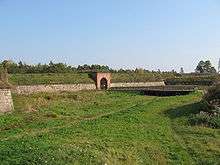Kyminlinna

Kyminlinna, ″the castle of Kymi″, is a fortress located in the northern part of Hovinsaari island in Kotka, Finland. Kyminlinna is part of the South-Eastern Finland fortification system built by Russia after Russo-Swedish War of 1788-1790. Kyminlinna formed the northern part of a double fortress together with Ruotsinsalmi sea fortress, where Kyminlinna was intended to repulse land-based attacks along the King's Road.
Kyminlinna is a five-corner caponier fortress approximately 800 metres in diameter. The surface area of the fortress is approximately 74 hectares and it forms the greater part of the Kyminlinna neighbourhood in Kotka. The fortress is surrounded by incomplete moats, which also form a part of the ditch system intended to keep the ground dry. The eastern part of Kyminlinna ramparts are cut by the Kotka railway built in 1890 and the Kymintie road built in early 20th century. National road 7 cuts the outer ramparts of the southern part of the fortress. The fortress area has 23 buildings, most of which have been empty after Finnish Defence Forces ceased using the fortress.
History
The first fortification built on the place where Kyminlinna stands was a bastion fortress of a few hundred metres in diameter built between 1791 and 1795. The construction of the fortress was first supervised by Russian marshall Alexander Suvorov. After Suvorov the construction work was led by Dutch-born general Jan Pieter van Suchtelen. This so-called Suvorov fortress was demolished to make room for the new, six times larger Kyminlinna that was built in the years 1803-1808. Suchtelen was also the designer of the new fortress and supervised its construction. The fortress was not quite ready by the time Finnish War began and the fortress lost its military value after the border between Russia and Sweden moved from Kymi River to Torne River. Kyminlinna did not see action during the Crimean War, when Ruotsinsalmi sea fortress was destroyed.
During the Finnish Civil War Kyminlinna was used by Red Guards as a training centre. Kyminlinna fortress saw its only battle during the civil war on April 9, 1918, when a German unit attacked the red guards in the fortress. The battle caused a few casualties, among them German Willy Heinz, who is buried in the Kotka old cemetery. Finnish song writer Veikko Lavi later made a song of the battle.
During the World War II Kyminlinna was used as refugee camp for Ingrian Finns. The fortress was also used as a prisoner of war camp, tuberculosis hospital and civil guard firing range. Kyminlinna was used by Finnish Defence Forces between 1939-2005. The area is currently owned by the Finnish government enterprise Senate Properties (Senaatti-kiinteistöt).
Sources
- Finnish national board of antiques Kyminlinna research
- http://www.ymparisto.fi
- http://kulttuuriymparisto.nba.fi
Coordinates: 60°30′26″N 26°53′19″E / 60.50722°N 26.88861°E
External links
| Wikimedia Commons has media related to Kyminlinna. |
| ||||||||||||||||||||||||